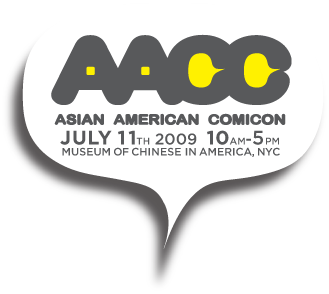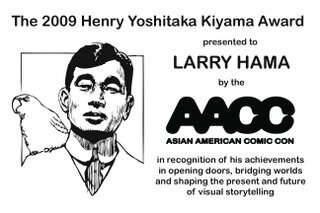Asian American ComiCon: July 11, 2009, Museum of Chinese in America, NY
 I nearly forgot about this upcoming event until I saw Larry Hama mention it on Facebook. He didn't mention that he was winning the Kiyama award, though. Congratulations, Larry! I first learned of the event at MoCCA Art Fest '09, when Charles Hatfield I had a great conversation with (and bought cool comics from!) Ken Wong. Ken's only one of the many cartoonists with stories in Secret Identities: The Asian American Superhero Anthology.
I nearly forgot about this upcoming event until I saw Larry Hama mention it on Facebook. He didn't mention that he was winning the Kiyama award, though. Congratulations, Larry! I first learned of the event at MoCCA Art Fest '09, when Charles Hatfield I had a great conversation with (and bought cool comics from!) Ken Wong. Ken's only one of the many cartoonists with stories in Secret Identities: The Asian American Superhero Anthology.Here's some information about the Con, which looks to have a very interesting, widely varied line-up of panels. But for full info, be sure to visit the Asian American ComiCon website.
Asian American ComiCon
The Museum of Chinese in America
215 Centre Street, New York, NY
July 11, 2009, 10 am to 5pm
The Museum of Chinese in America
215 Centre Street, New York, NY
July 11, 2009, 10 am to 5pm
As artists, editors, writers and fans, Asian Americans have been a key creative force behind the graphical storytelling movement.
That's why some of the industry's leading Asian American creators have collaborated to organize this celebration of the unique contemporary role and historical legacy of Asians in the world of comics and cartoon art.
The event will bring together top artists, writers, fans and readers of mainstream and alternative graphic fiction with the larger Asian American community for a one-of-a-kind gathering, incorporating education, dialogue, spontaneous creativity, intergenerational outreach and the chance for established and emerging talent to show off their work.
 WHY THE KIYAMA AWARD?
WHY THE KIYAMA AWARD?The organizers of AACC want this annual award to recognize the contribution of Asian and Asian Americans to U.S. comic book culture. No one better exemplifies that contribution than Henry Yoshitaka Kiyama, whose career represented the convergence of two worlds and industries, and whose work pointed the way to the future of graphic storytelling.
Kiyama published his breakthrough book The Four Immigrants in 1931. A poignant collection of cartoon stories about life as a Japanese student expatriate in the U.S. in San Francisco during the early part of the 20th century, it explores the issues these early immigrants faced in a world whose language, culture and traditions are new, strange and confusing.
Though the stories were originally intended for newspaper serialization, Kiyama never published them in that form, ultimately releasing them as a single book-length collection. This publication format, along with the fact that the stories in Four Immigrants featured a group of semiautobiographical characters (based on Kiyama and his friends) who grew, evolved and contended with real historical issues and events, has led some to advocate that it be recognized as the first original graphic novel published in America (arriving a decade before Virginia Lee Burton's 1941 Calico the Wonder Horse
Labels: Asian Americans, conventions, Hama, Kiyama, KWong, manga, race


0 Comments:
Post a Comment
<< Home